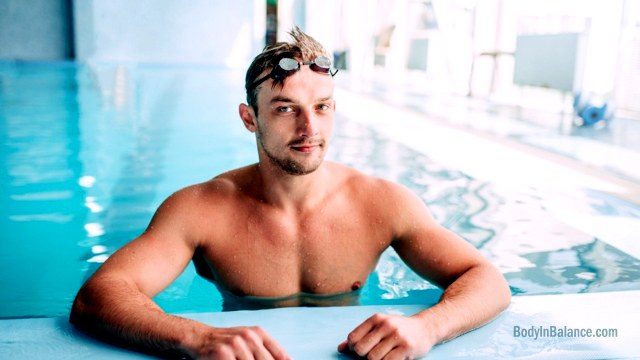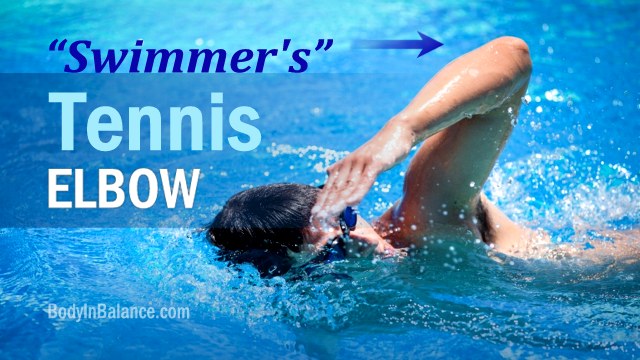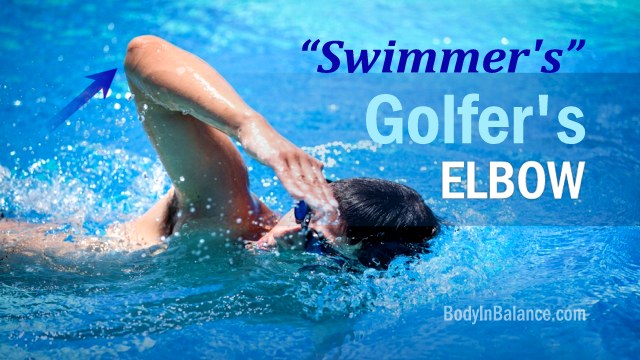
Whether you developed your injury while swimming and think of it as Swimmer’s Elbow…
OR you developed a Tennis Elbow or Golfer’s Elbow injury some other way – but happen to love to swim – there are probably two or three big questions on your mind:
- Is swimming good or bad for Tennis and Golfer’s Elbow? – Does it cause or aggravate it? (And is there really such a thing as “Swimmer’s Elbow”) Cause? [Skip to this section]
- Could swimming possibly be a helpful rehab exercise for it at? – (Especially if swimming wasn’t what caused the injury in the first place) Good rehab? [Skip to this section]
- OR should you definitely stop swimming until your injury heals? – (Especially if swimming IS what caused the injury in the first place) Rest it? [Skip to this section]
Let’s dig into the question of causation and aggravation…
Yes, Swimming Can Cause (OR Aggravate) Either Tennis Or Golfer’s Elbow
This is going to be pretty self-explanatory IF you developed your injury swimming in the first place.
Yes, swimming can certainly cause AND exacerbate both Tennis Elbow and Golfer’s Elbow.
The #1 injury area for swimmers is the neck and shoulder, with Rotator Cuff tendon problems being extremely common.
“Shoulder pain is the most frequent orthopaedic injury in swimmers, with a reported prevalence between 40% and 91% In contrast to most other sports, where the legs initiate the propulsive force, swimming athletes primarily use their arms to generate forward thrust. Swimmers at the elite level may swim up to 9 miles per day (more than 2500 shoulder revolutions).”
Epidemiology of Injuries and Prevention Strategies in Competitive Swimmers
Ncbi.nlm.nih.gov | Articles | Sports Health 2012 May; 4(3): 246–251. PMC3435931
And the compensation patterns involved with these Repetitive Strain-type injuries, often lead to elbow pain and injury, too. (More on that in a bit.)
There are also well-known issues with swimming stroke biomechanics that can directly cause elbow pain and injury.
One example, thanks to an article in ‘Feel For The Water’ results in: (See quote below and animated GIF image above.)
“…locking out the elbow at the rear places a huge amount of stress on the elbow joint, commonly resulting in elbow pain or injury.”
“Watch Nicola demonstrating her stroke. Notice the distinct push at the rear and how the elbow joint is being hyper-extended to the very limits of its range of motion:”
“In nearly every case, elbow pain or injury from swimming is caused by this over-emphasis at the rear of the stroke.”
Feel For The Water Getting Elbow Pain From Swimming?
If you have what’s sometimes called “Swimmer’s Elbow” from swimming, feel free to keep calling it that – Since that’s how you got it!…
However, technically, it’s probably going to be “diagnoseable” one of two conditions, regardless of whether you got it from playing tennis, golfing, computing or swimming:
- It’s probably Tennis Elbow – If it’s affecting your outer elbow (also known as Lateral Epicondylitis / Epicondylopathy)
- It’s probably Golfer’s Elbow – If it’s affecting your inner elbow (also known as Medial Epicondylitis / Epicondylopathy)

Swimming can cause or aggravate Tennis Elbow
And, generally, when it comes to these types of Repetitive Strain Injuries, that happen over time and not all at once…
The activity that causes the injury is naturally going to be one of the most aggravating things for it.
If swimming caused your elbow injury then it may be best to stop until you’ve made some progress healing it first.
Although that’s not a hard line rule – See section #3. on whether to stop and rest for more.
(For example, sometimes tennis players CAN keep playing as they’re recovering from Tennis Elbow.)

Swimming can cause or exacerbate Golfer’s Elbow
However, what if you developed your injury some other way?
Can Swimming Be A Good Form Of Rehabilitation?
Yes, swimming may be helpful to you, if you developed your injury from something other than swimming (or primarily from some other activity.)
Perhaps playing tennis or golf (golfer’s get Tennis Elbow pretty often!) or maybe gardening or working on your computer
In that case, swimming might turn out to be a good form of rehab for you!…
(Although not necessarily as the very first phase of your rehab.)
No matter what, though, it’s going to come down to trial and error.
Hopefully not a disastrous error – If you’re cautious!
But you’ll still have to “test the water” and see.
So, here are some things to consider, first:
Water Temperature
It may end up making a big difference whether you’re swimming in a heated pool or not.
Cold water inhibits circulation and sucks heat away from your body and, as a result, your muscles and tendons don’t perform optimally.
(If you’re swimming in the cold ocean, this is of particular concern.)
However, even “heated” pools – can be on the cooler side.
Despite what you may have heard about cold, ice and Tennis Elbow…
Cold (or ice) is not what you want on or around your Tennis or Golfer’s Elbow.
Especially not cold as you’re exercising!
See also my article and video about why you should NOT ice your elbow – If it’s a chronic tendon injury.
You may be fine with swimming in cooler water but, then again, you may find that your forearm muscles remain stiff and sore in the pool.
If you have access to a whirlpool / Jacuzzi near the pool, it may help to sit in that for a few minutes before swimming to heat and loosen your muscles.
And you can try returning to the hot tub one or more times, after a few laps, if you feel your elbow stiffening up on you.
(And while you’re there, be sure to use the jets to massage your forearm muscles and even your tendons if it feels right!)
Your Rotator Cuff
The other major consideration has to do with the ‘biomechanical’ nature of swimming and how it affects your shoulder.
Again, shoulder / Rotator Cuff injuries are the most common problems suffered by swimmers.
Yes! On the big plus side, swimming is a low / zero impact exercise (as long as you don’t hit the wall of the pool!)
However, the major strokes involved in swimming do place a high demand on the shoulder.
Not that it requires a lot of strength and force but, rather, that you have to take your shoulder through its full range of motion.
And you have to do it over and over – Every stroke, lap after lap.
The crawl and the backstroke, in particular, require full flexion and abduction of your shoulder.
This is not a problem if your Rotator Cuff is strong and fully functional…
But if it’s not, it will tend to cause problems.
AND the #1 area that you tend to compensate for a weak / unstable Rotator Cuff is in the muscles of your wrist, in your forearm.
Those are your “Tennis Elbow / Golfer’s Elbow Muscles”
So, for example, if your shoulder is weak and unstable at full flexion…
(Probably because of Rotator Cuff muscle weakness.)
You may have a tendency to tighten through your biceps and/or triceps and even down into your wrist muscles in your forearm.
With the result that every time you reach overhead in your crawl stroke, you feed more excessive tension into your Tennis or Golfer’s Elbow Muscles, exacerbating the pain at your elbow.
(There are other possible patterns, of course.)
Should You Stop Swimming Until Your Injury Heals?
If swimming is the activity that caused your elbow injury in the first place…
Then it’s probably going to continue to aggravate it if you continue to swim.
At least if you continue swimming as often and for as many laps, miles or kilometers each time.
But if you need or love swimming so much…
Perhaps because it’s the only cardiovascular exercise you can tolerate, since it’s weightless and zero impact on your joints…
(OR you just can’t live without it or don’t have other options!)
Then at least consider reducing your frequency and duration.
Anything you do EVERY DAY when you’re injured – Not allowing your body sufficient recovery time – Is going to tend to exacerbate your injury.
And, (in my opinion) there’s a high degree of likelihood you have a Rotator Cuff issue underlying your elbow issue…
And you may be much better off strengthening that with rehab exercises and working on your Swimmer’s Elbow.
Other Tips On Swimming While Injured
If you really need to be in the water, and are still recovering from an elbow or shoulder injury, consider:
- Using a flotation device – either wearing flotation gear that makes you more buoyant
- OR holding onto a board and focusing on kicking and resting your arms – (perhaps not the entire time in the pool/water but after your elbow begins to bother you)
- Or using a snorkel – so you don’t have to raise or turn your head to breath and you can modify your strokes (perhaps switching to a slow, easy breast stroke, which involves a smaller range of motion)
What If Swimming Didn’t Cause Your Injury?
If swimming isn’t the activity that caused your injury, then it may turn out to be good therapy for it.
You may still have a Rotator Cuff issue underlying your Tennis or Golfer’s Elbow…
(Most people do, in my experience, working with Golfer’s and Tennis Elbow sufferers almost exclusively for 15 + years.)
But by simply changing your primary activity – say, from tennis or golf to swimming…
You change your movement patterns and muscular demands, which may help strengthen underused muscles, including those of your Rotator Cuff…
And changing your activity reduces the patterns of repetitive strain / overuse.
Again, you still have to test it out.
You may find it does wonders…
Then again, you may find it aggravates the heck out of your injury.
Whatever you do, don’t start swimming a lot of laps/miles or too frequently right away if you’re not accustomed to it.
It’s important to start slow and, ideally, allow at least 1 rest and recovery day – (better yet 2) in between swimming days.
There may be a delayed reaction – meaning you may not feel the results or reaction to the swimming for a few days.
This article originally appeared on my Tennis Elbow Classroom site. For the full, original article please visit:
Article and video on Swimmer’s Elbow
Treatment in Marin / San Francisco
If you’re in the Bay Area, please see my page about how I treat Tennis Elbow:
My approach to Tennis Elbow therapy
You get 100% hands-on Neuromuscular Therapy to help your muscles and tendons heal and recover naturally without dangerous drugs or invasive measures.